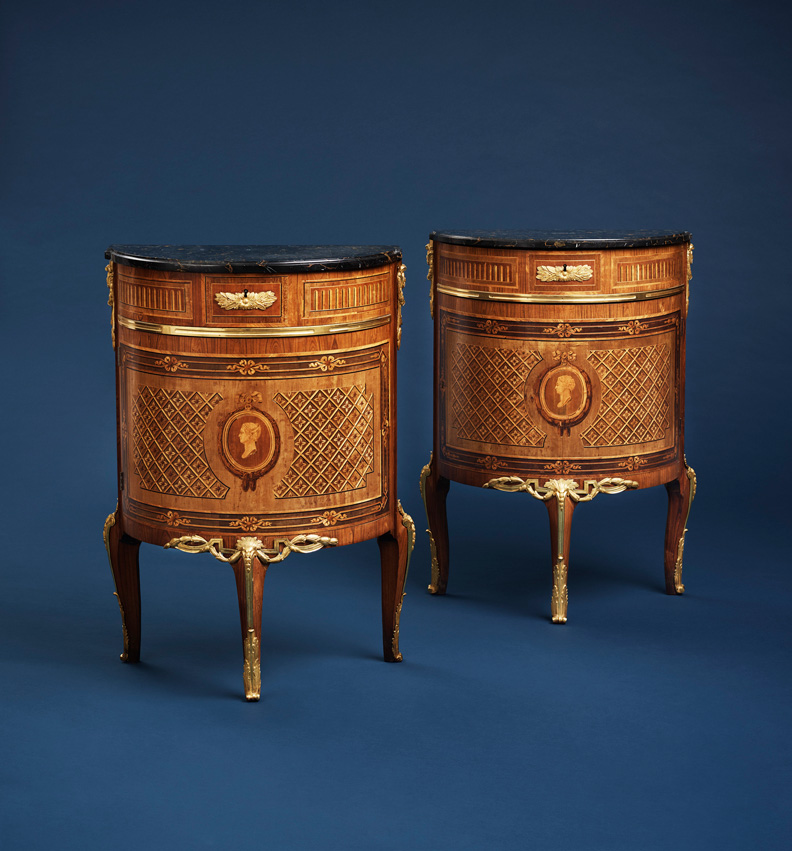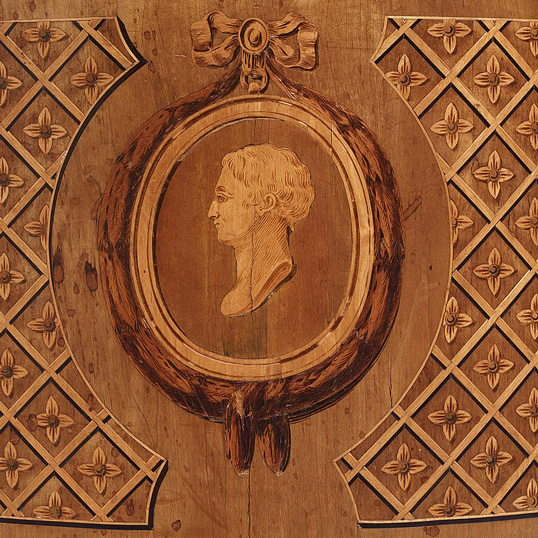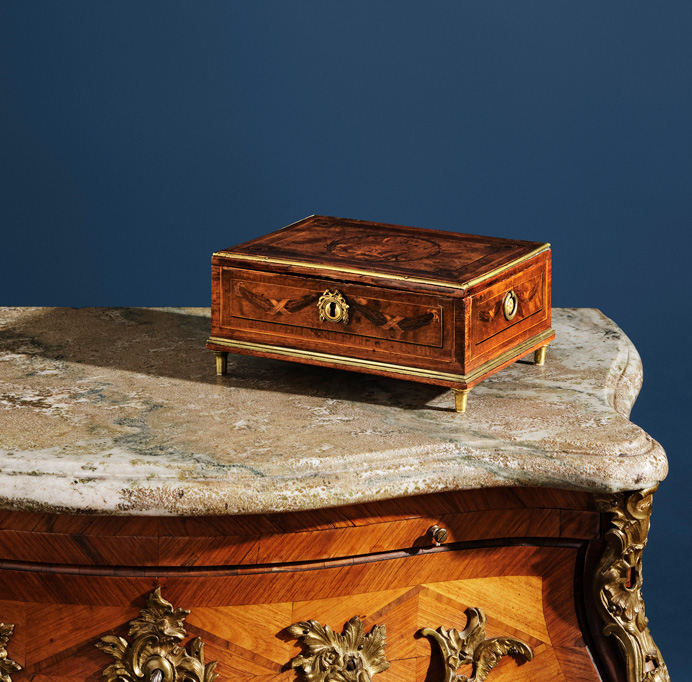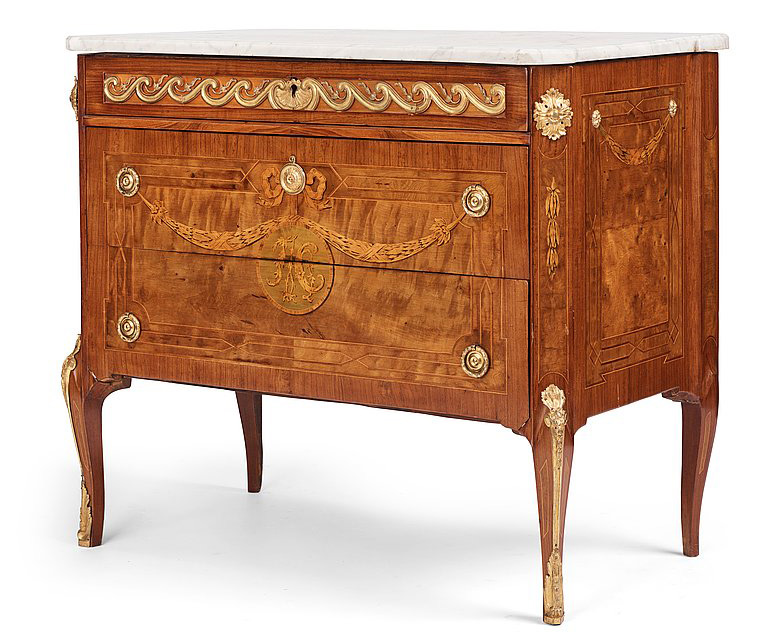Bukowskis presents Georg Haupt at Important Winter Sale
Georg Haupt
Bukowskis presents exceptional furniture and craftsmanship by the master Georg Haupt at the season's Important Winter Sale. Highlights from the auction include a pair of cabinets with unbroken provenance since their creation around 1780, now offered at auction for the very first time. The auction also presents a wonderful commode and an unusual marquetry box with a cover by Haupt.
The De Geer cabinets
– unparalleled craftsmanship and design
The two cabinets in the auction embody everything associated with Georg Haupt: refined design and decoration, innovative style, and his legendary craftsmanship. Among known works by Haupt these cabinets hold a special position with their unique design and technically advanced execution. Haupt introduces a type of furniture that had not previously existed in Sweden. Furniture with semi-circular facades can be found in both France and England, and as Lars Ljungström has shown, Haupt drew inspiration from England, where the emphasis is on volume and the facades have doors. However, the cabinets in the auction are narrower, resulting in a semi-circular door. Constructing a 180-degree curved surface and decorating it with rich marquetry decoration demonstrates a technical skill possessed by no other Swedish cabinetmaker during the 18th century.
As on several of Haupt's most exclusive furniture pieces, he has for the tops chosen precious imported marble, in this case, black and yellow speckled marble, known as portor. Portor surfaces can be found, for example, on the pair of encoignures, corner cabinets, and bookcases by Haupt from around 1780, which were previously located in Gustav III's Divan Room at the Royal Palace in Stockholm. On the pair of corner cabinets, it can be seen that the precious and custom-made surfaces likely arrived when the cabinets were almost finished. The surfaces are elegantly thin at the front edge, but then become thicker and roughly hewn underneath, a thickness that Haupt had not anticipated. Afterwards, he had to use a chisel to make substantial hollows in the upper blind panels of the corner cabinets to accommodate the thick surfaces.
On one of the cabinets in the auction, the one with the male medallion, we find the same phenomenon, indicating that it had been completed when the marble tops arrived. To avoid this on the other cabinet, Haupt raised the facade slightly to accommodate the thickness, resulting in a one-centimeter increase in height.

To truly showcase his masterful craftsmanship, Georg Haupt has not only settled for a semi-circular surface on the cabinets presented at the auction. He decorates it with unusually abundant marquetry in the form of lattice patterns with small rosettes, grillwork, and a classical portrait medallion, fluting, frameworks, and ribbon rosettes. Additionally, we find his refined shading to create a sense of depth. Haupt himself described the decoration in an invoice for a table in 1777 for Princess Hedvig Elisabeth Charlotta as "inlaid medallion and antique head, along with mosaic." We recognize the motif from some of Haupt's most famous furniture pieces, such as the so-called Österbybruk Secretaire from 1779 (private collection) and the pair of secretaires commissioned by Prince Fredrik Adolf in 1778, now at Tullgarn Palace.
As Lars Ljungström writes in his catalog from the Haupt Exhibition at the Royal Palace, Stockholm, in 2006, these cabinets are exceptionally well-preserved. The untouched surfaces offer an opportunity today to appreciate Haupt's way of composing marquetry and how he brought it to life with his unparalleled engraving skill.
Catharina Charlotta Ribbing and the De Geer Palace
The cabinets were commissioned by the famous Baroness De Geer, Catharina Charlotta Ribbing af Zernava (1720-1787). She belonged to the influential elite of her time and had a strong personality. It caused a great stir when she became the first in "high society" to inoculate her children against smallpox, resulting in Carl Gustaf Tessin having a medal struck in her honor in 1756. At the age of only 23, she married one of the wealthiest magnates of the time, Baron Charles De Geer af Leufsta (1720-1778). This allowed her to freely pursue her interests in architecture, art, and interior design, which can still be seen at Leufsta, Stora Wäsby, and Svindersvik. Baron Charles De Geer had purchased the plot on the corner of Västra Trädgårdsgatan and Kocksgränd. There, he began building a house that could serve as a future widow's residence, although it was not completed at the time of his death in 1778. It was up to his widow to finish the house (now the residence of the Finnish ambassador), and she had the assistance of Jean Eric Rehn. In his own handwritten catalog, Rehn writes: "built from the ground up the current house of the Baroness De Geer on Västra Trädgårdsgatan, as well as the entire interior of the same house." As a widow, Catharina Charlotta De Geer remained very wealthy and maintained a grand house in Stockholm and was part of Gustaf III's personal circle, where she had the opportunity to see the works delivered by Georg Haupt.
At Charles' death in 1778, the auction's cabinets are not listed in the estate inventory, so we can assume that it was Catharina Charlotta who ordered them in the latest style from Haupt. She moved into the house in 1784, the same year Haupt died, which allows us to confidently date the cabinets between 1778-1784. This also aligns stylistically, as we have seen, with other furniture Haupt produced during this time for the king and others. Just three years later, Catharina Charlotta dies, and through her estate inventory in 1787, we can get an idea of the rich interior of the De Geer Palace. Her grand bedroom was used for entertaining. The decor was in white and gold with rich red textiles and furnished with no less than a suite of 13 seating furniture, two gilded console tables, and 7 pieces of veneered furniture. Among the latter, the auction's cabinets are listed: "2 Half-round small bureaus with brown marble tops, various types of inlaid wood, and gilded mounts." It is interesting to note the mixture of colors of the tops, with white, gray, and brown marble tops being used in the same room.

The exact placement of the cabinets in the room is not specified, but on a preserved floor plan, narrow pilasters are drawn on either side of a fireplace, which is not found in other rooms. These pilasters have the same width as the auction's cabinets, indicating that the cabinets most probably were placed against them, flanking the tiled stove.
The house and the majority of the interior were inherited in 1787 by the youngest son, Louis De Geer (1759-1830), and from the estate inventories of his two wives (1794 and 1815), it is evident that the cabinets remained in the bedroom. In 1818, he sold the palace and moved the cabinets to Nyköping and Christineholm. In the estate inventory of his grandson Carl Fredrik Wachtmeister in 1889, the cabinets are placed in the salon there, where they have remained until recently.
With their unbroken provenance, unique design, and untouched condition, the auction's cabinets offer an opportunity to acquire a unique piece of Swedish 18th century.
To be sold at Important Winter Sale
Estimate 6 000 000 - 7 000 000 SEK

A Gustavian marquetry box with cover
One of Haupt's favorite motifs on furniture was medallions featuring antique-style profiles of men and women. The portrait medallion appeared already on Haupt's masterpiece and can be traced back to Jean-Charles Delafosse's models in "Nouvelle Iconologie Historique" from 1767. The portrait of Haupt's masterpiece depicts Queen Lovisa Ulrika. However, generally, the figurative heads did not represent any specific person. Haupt himself described the motif type as an "inlaid medallion and antique head" in an invoice to Princess Hedvig Elisabeth Charlotta in 1777. The medallion on the auction's box—a genre painting of an embroidering woman—is interesting as it only appears three times in Haupt's known production: the other two instances are on furniture from the Bielke collections at Sturefors, secretaire, and a table dated 1781, of which the table was sold at Bukowskis in 2022 (Important Spring Sale 641, cat. no. 24).
To be sold at Important Winter Sale
Estimate 100 000 - 120 000 SEK

A Gustavian commode
The auction’s commode is an excellent example of how Georg Haupt was skilled at keeping up with the taste and style of the late 1780s. At first glance, the commode may seem quite ordinary. But the details of the festoons and the inlaid medallion and monogram, as well as the curved veneer of the legs, reveal the master's hand, as well as the perfect proportioning and secure shading. In addition, the unusually rich use of precious woods and carefully selected veneer sheets signaled exclusivity and status for the contemporary society, as always in Haupt's marquetry- furniture.
Among Swedish cabinetmakers, Haupt is the only one to use inlays of monograms formed by foliate scrolls. In some cases, these are very legible - as in the case of a series of furniture ordered by the Sparre family, adorned with clear S’s - but more commonly, the monograms are almost abstract and can often be read as to form several combinations of letters. Like Haupt's portrait medallions, which are usually part of a general arsenal of motifs - such as an "antique head" - and not specific portraits, it is possible that in some cases the monograms never intended to represent a specific combination of names, but rather should be regarded as abstract compositions.
To be sold at Important Winter Sale
Estimate 1 400 000 - 1 600 000 SEK

The furnitures and works of Art will be sold at Important Winter Sale
Viewing November 30th – December 5th, Berzelii Park 1, Stockholm
Open weekdays 11 am – 6 pm, weekends 11 am – 4 pm
Live AuctionDecember 6th – 8th, Arsenalsgatan 2, Stockholm
Read more about the auction and discover the full catalogue
Requests & condition reports Contact specialist

Stockholm
Björn Extergren
Head of Consignment and Sales Department, Fine Art. Specialist Antique Furniture, Decorative Arts and Asian Ceramics
+46 (0)706 40 28 61

Stockholm
Carl Barkman
Head Specialist Fine Art and Antiques
+46 (0)708 92 19 71
























